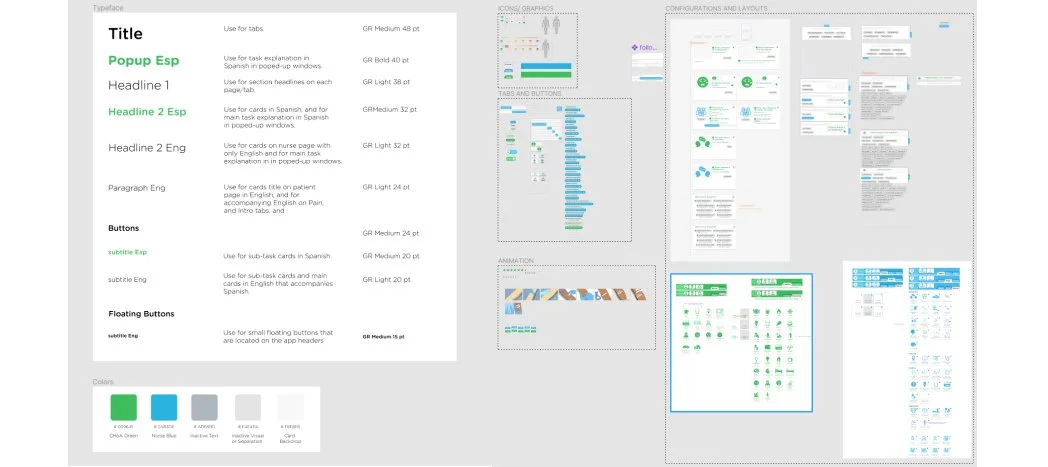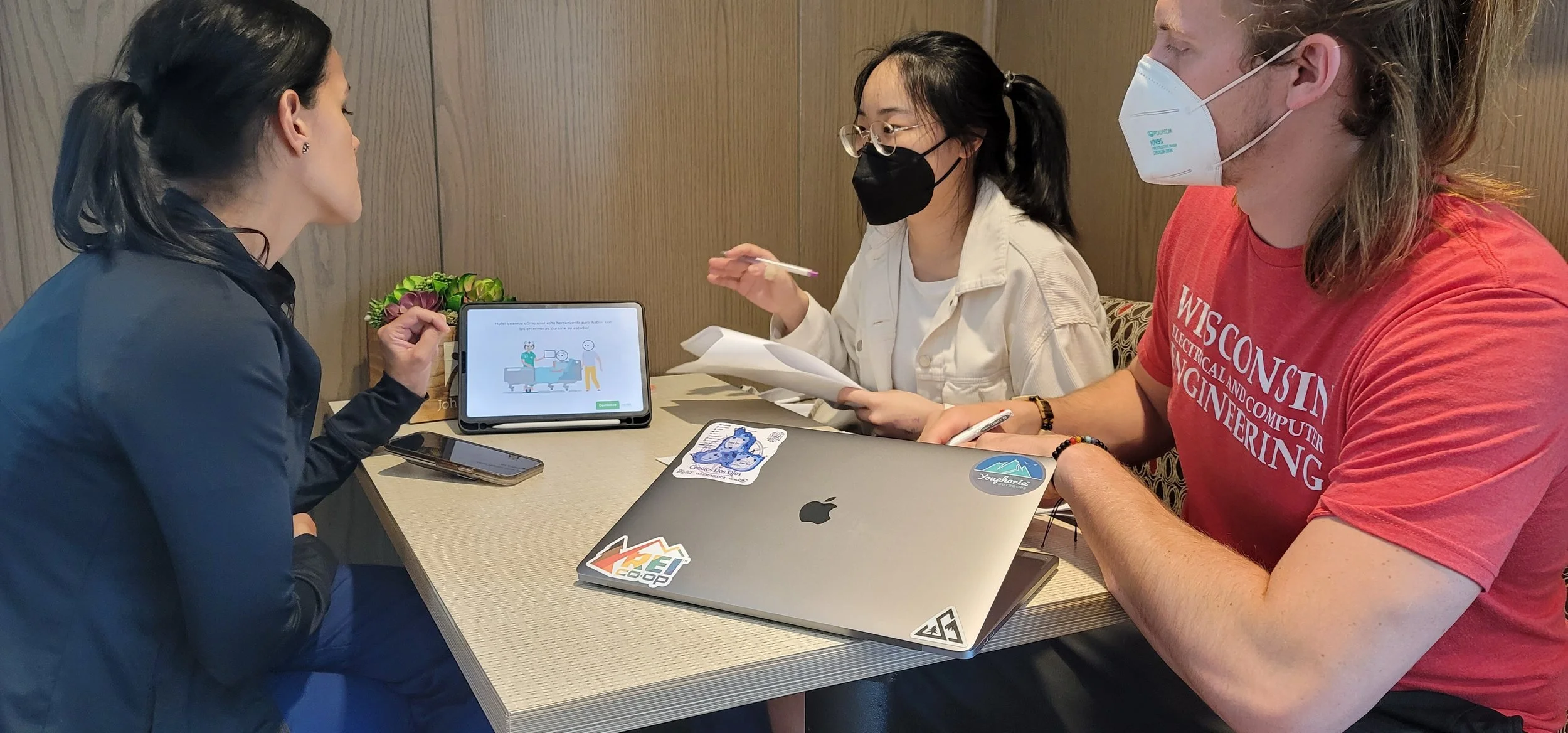During my time working at AppHatchery at Georgia CTSA (Clinical & Translational Science Alliance), I created a digital tool for nurses to communicate providing quick and basic point-of-care tasks to low English proficiency patients and families at CHoA (Children's Healthcare of Atlanta) hospitals.
🎉Our app has been developed and launched, now used on 3 floors of CHoA!
Overview
Timeline
Jan - April 2022: User Research and Early Design
May - Aug 2022: High-Fi Design Iterations, Usability Tests, Early-Mid Development
Team
🙋♀️ (Designer since Jan, sole Designer since May)
1 other Designer/Researcher (Jan - April 2022)
1 Product Manager
1 Developer
My Contribution
I Participated in:
I Led:
- User and stakeholder interviews
- Ideation and low fidelity prototyping
- User feedback for initial ideas
- Feature ranking for development prioritization
- Testing and feedback of developed app versions
- Hi-fi prototyping and iterations based on feedback
- Design system and component crafting
- Handoff and design updates to developer
- Research plan for onsite usability tests
- Scheduling and conducting usability tests
The Problem
Low English Proficiency (LEP) patients have decreased understanding, increased risk for adverse events, and lower healthcare satisfaction, because
language barriers hamper nurses’ ability to provide care.
Our Solutions
Bilingual tool for quick and easy nurse-patient communication without having to request for interpreters.
— Nurses Can:
Introduce Themselves to Family/Patient
Ask About Pain Situation
Tell Patient/Family Tasks They Are Going To Perform and/or Give Quick Status Updates
— Patients and Family Can:
Tell Nurses How They Feel or What They need
Ask Questions or Request Help From Interpreters
How did we get here?
1. Discovery & Problem Identification
How Are Nurses and LEP Patients Communicating Now?
1. Online and In-person Interpreters
😃 services available in a range of languages
😟 difficult to call on depending on time and languages
* images from https://cyracominternational.com
2. Paper Communication Board
😃 good for communicating quick tasks nurses perform and things patients need
😟 have not been used a lot due to lack of maintenance and limited flexibility
Who Else Can We Talk To?
To understand the problem and current solutions better, we interviewed:
We were able to learn about:
2. Current Solutions- interpreting services and paper board- how they’re being used and what’s working vs. not working
1. In General- communication patterns and challenges between LEP family/patients and nurses
Through user research, we gathered these insights…
About Current Solutions
The board works well for quick Point of Care (POC) tasks and is not to substitute an interpreter
Boards are difficult to find and retrieve in the nursing station and aren’t widely used
The board is limited in supporting range of tasks nurses perform and various levels of language literacy
About Communication
Interpreters are difficult to call on depending on time and languages
It is a large communication barrier to tell families status updates and actions nurses will perform
LEP family feels embarrassed by needing interpreters and avoids creating any inconvenience
… which are helpful to further define the problem statement:
“How can we design a communication tool for nurses and LEP patients & family for simple and quick tasks?”
We were not able to meet real patients yet- what can we do instead to learn about the use case and scenarios?
After our initial user interview, we still wanted to gain more understanding of the specific contexts and scenarios of using the tool at the hospital. But due to IRB constraints and onboarding process, we were not allowed onsite at the hospital yet. Therefore, we performed role playing activities with colleagues inside AppHatchery as well as UX experts from my master program. This “variation of contextual inquiry” was not an accurate reflection of communication situations at the hospital, but it allowed us to catch useful details that were missed during user interviews.
Design Requirements
Functional
Non-Functional
These design requirements we defined together with our clients got us to a place where we were confident to conclude formative research and move to the next phase…
02. Design Development
Kicking Off By Brainstorming
We conducted brainstorming sessions, using techniques including springboarding, brainwriting, and then speed sketching, to generate a variety of ideas. The sessions were conducted with our PMs and software engineer, as well as our clients, to keep everyone involved and on the same page.
Comparative Analysis and What’s Relevant
Initial Ideas
Wireframing and Low Fidelity Prototypes
As a team, we selected 2 ideas to create wireframe and low fidelity ideas for (only showcasing the one I was in charge of). We reviewed both ideas internally and made adjustments for our first round of prototype evaluation.
Prototype Evaluation and Idea Merging
We evaluated our low-fi prototypes with 5 nurses,1 interpreting manager, and 2 Spanish speaking moms. From their feedback, we were able to merge our 2 ideas into one to further develop depending on what was working and what needed more considerations.
Design Guidelines
As I continued to work as the sole designer on the team, I took charge of creating high fidelity prototype and interactions since May 2022. I also created component-based design guidelines and kept track of design updates by documenting changes in Figma.
03. Testing and Iterating
Research Planning and Findings Documentation
Usability tests can get chaotic very easily, so planning in advance and documenting observation and findings clearly are very important. I made templates that contained both research activity guidelines and sections for writing down observation and design implication.
Usability Tests Onsite
CHOA’s internal publication covering our project
What I Learned:
Advocating and speaking up for users as a human centered designer in front of authorities and other stakeholders
Being flexible and adaptive for unforeseen situations and acting fast in response
Not being stuck under ambiguity and rely solely on support from client- be resourceful!
Management
project management and time management
sponsor and client expectation management
Next Steps
We’re trialing the app on 2 entire floors at CHOA’s Scottish Rite campus and making final adjustments before launching. Stay tuned!


























